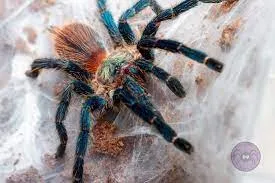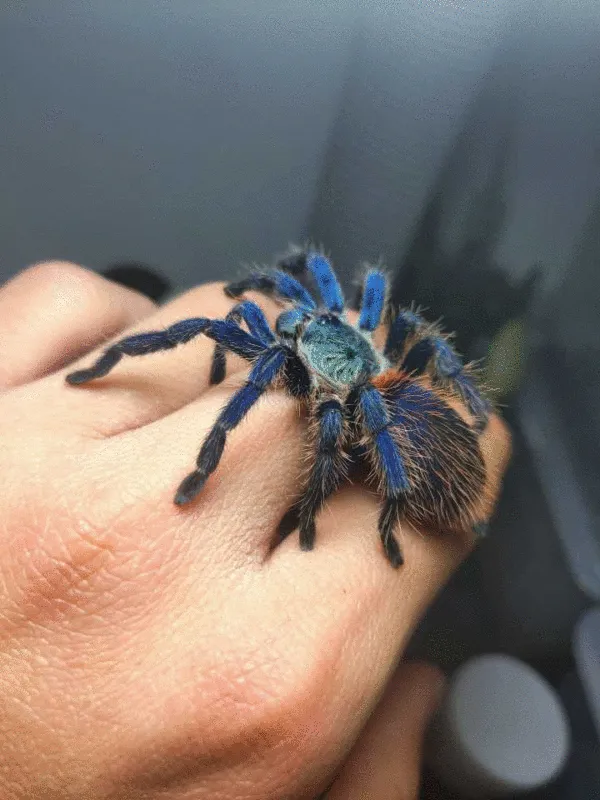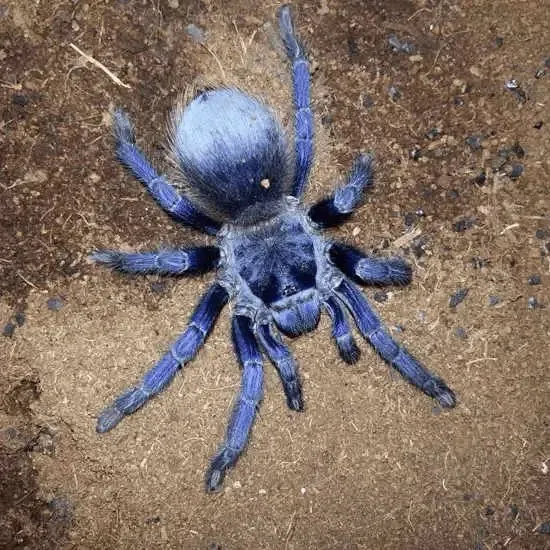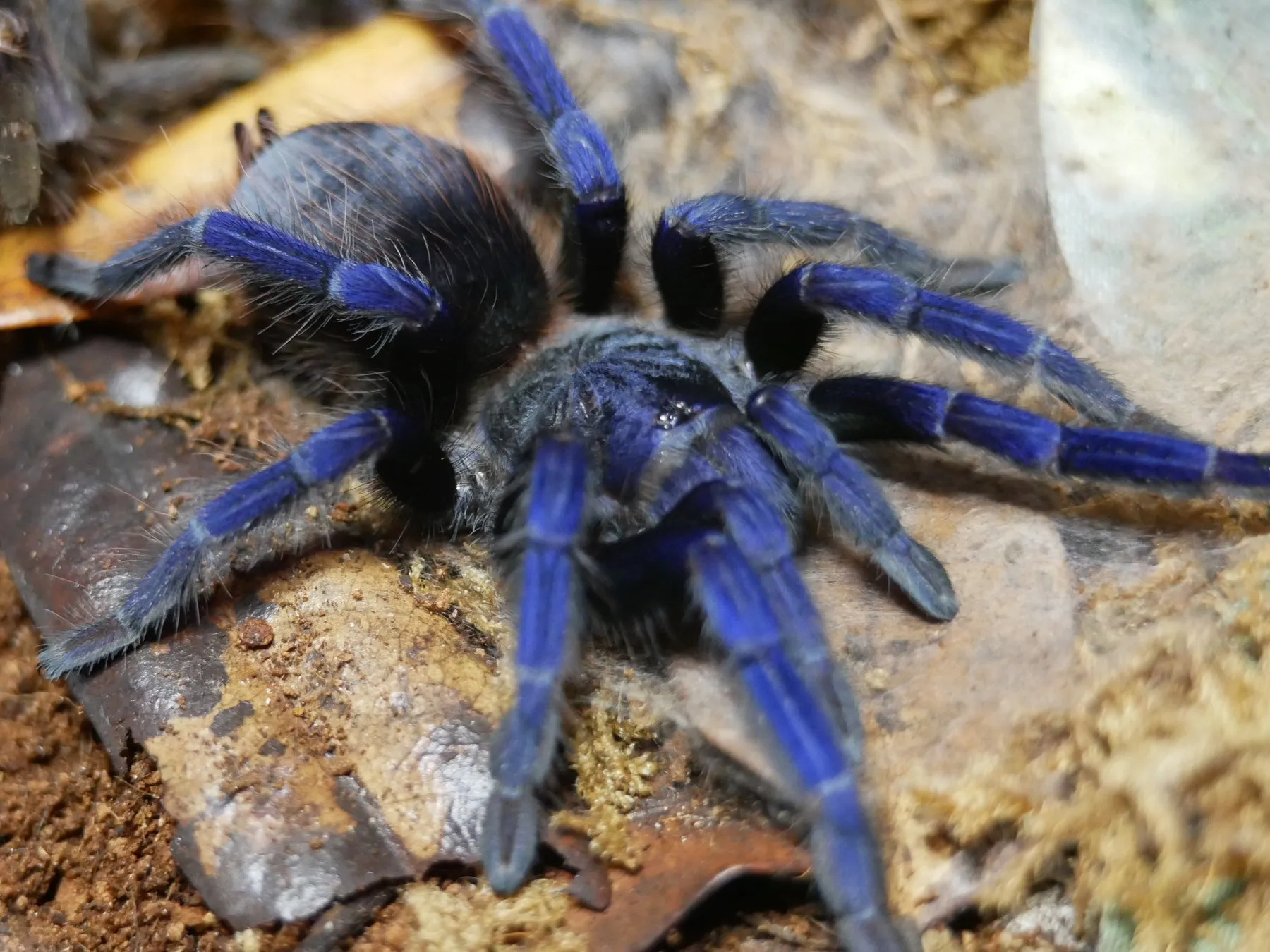What is the Brazilian Blue Tarantula?
The Brazilian Blue Tarantula ( Pterinopelma sazimai ) is a vibrant and captivating species, highly sought after by tarantula enthusiasts. Originating from Brazil, these arachnids are known for their striking iridescent blue coloration, particularly noticeable in juveniles, which gradually fades as they mature. The Brazilian Blue Tarantula’s appeal extends beyond its appearance; it is also relatively docile, making it a popular choice for beginner and intermediate keepers. Understanding the size of a Brazilian Blue Tarantula is crucial for providing proper care, from selecting the right enclosure to ensuring adequate nutrition. This guide provides a comprehensive overview of everything you need to know about the size of these fascinating creatures.
Brazilian Blue Tarantula Physical Characteristics
Beyond their captivating blue hues, the Brazilian Blue Tarantula exhibits several other physical characteristics that are important to note. Their bodies, like those of all tarantulas, are divided into two main parts the cephalothorax (prosoma), which combines the head and thorax, and the abdomen. They have eight legs, two pedipalps (used for sensory purposes and handling food), and chelicerae (fangs) used for injecting venom. The overall body shape is typical of tarantulas, with a slightly flattened appearance. The hairs on their bodies, which are often urticating (causing irritation), play a role in their defense mechanism. These hairs can be flicked off when the tarantula feels threatened. As juveniles, the blue coloration is most vibrant, appearing on the legs, carapace, and abdomen. As they grow older, the blue may become less intense, often transitioning to a more brownish or muted tone, especially in females. However, even as adults, they retain some of their blue iridescence, making them visually appealing.
Size of Brazilian Blue Tarantulas Male vs Female

Sexual dimorphism is a key aspect to consider when discussing the size of Brazilian Blue Tarantulas. Females generally tend to be larger and more robust than males. Adult females can reach a leg span of approximately 5 to 6 inches (12.7 to 15.2 cm), while males typically are slightly smaller, with a leg span closer to 4 to 5 inches (10.2 to 12.7 cm). This difference in size becomes more pronounced as the tarantulas mature. The lifespan also contributes to size variations; females live significantly longer than males. This means that females have more time to grow and develop, leading to their larger size. Males, on the other hand, tend to mature faster and have a shorter lifespan, which affects their ultimate size. When determining the sex of a tarantula, the size difference, along with other physical characteristics such as the presence of sperm webs in mature males and the shape of the epigastric furrow in females, can be used as indicators.
Size Influencing Factors for Brazilian Blue Tarantulas
Several factors influence the ultimate size a Brazilian Blue Tarantula achieves. Genetics plays a significant role; some tarantulas simply have the potential to grow larger than others within the species. Diet and nutrition are crucial, with a balanced diet of appropriately sized insects contributing to healthy growth. Consistent feeding, especially during the growth stages, is essential. Environmental conditions also affect size; a warm and appropriately humid environment can promote healthy molting and growth. Adequate space in the enclosure is also important, as overcrowding can lead to stress and stunted growth. Regular molting is another critical element influencing size, as tarantulas shed their exoskeletons to grow. Each molt allows the tarantula to increase in size. The frequency of molting decreases as the tarantula matures. Finally, the overall health of the tarantula and the absence of any diseases or parasites are vital for achieving its maximum size potential. Careful attention to these factors will help ensure that your Brazilian Blue Tarantula grows to its full potential.
Diet and Nutrition Effects on Size
A well-balanced diet is fundamental for the proper growth and development of Brazilian Blue Tarantulas. The size and frequency of feeding should be adjusted based on the tarantula’s age and size. Spiderlings and juvenile tarantulas require more frequent feedings, usually 2-3 times a week, with appropriately sized prey such as pinhead crickets or small mealworms. As the tarantula matures, the feeding frequency can be reduced to once or twice a week. Adult tarantulas can often be fed once a week or every other week, depending on their appetite and metabolism. It’s crucial to offer a variety of insects, such as crickets, roaches, mealworms, and occasionally, waxworms, to ensure the tarantula receives a range of nutrients. The size of the prey should also be appropriate for the tarantula; the prey should be no larger than the tarantula’s body. Overfeeding can lead to obesity and other health problems, while underfeeding can stunt growth. Always remove any uneaten prey within 24 hours to prevent stress and potential harm to the tarantula. Proper hydration is also essential, so a shallow water dish should always be available.
Brazilian Blue Tarantula Growth Stages

Brazilian Blue Tarantulas, like all tarantulas, grow through a process called molting. This involves shedding their exoskeleton to allow for growth. Spiderlings molt frequently, sometimes every few weeks, as they are rapidly growing. As they mature, the molting frequency decreases. Juveniles typically molt every few months, while adult tarantulas may only molt once a year or even less frequently. Each molt is a vulnerable time for the tarantula. It is essential to maintain optimal environmental conditions during this period, including adequate humidity and a safe, undisturbed environment. The size increase during each molt varies, but it is typically noticeable, particularly in younger tarantulas. Before a molt, the tarantula may exhibit behavioral changes, such as a decreased appetite or lethargy. After molting, the tarantula’s new exoskeleton will be soft and fragile, and it will take several days for it to harden. During this time, the tarantula is particularly susceptible to injury and should be handled with extreme care. The size of the tarantula gradually increases with each successive molt until it reaches its adult size.
Caring for Your Growing Brazilian Blue Tarantula
Providing proper care is paramount for the health and growth of your Brazilian Blue Tarantula. Maintaining the correct environmental conditions is essential. This includes a temperature range of 75-85°F (24-29°C) and a humidity level of 65-75%. Monitoring these parameters using a thermometer and hygrometer is highly recommended. The enclosure should be appropriately sized for the tarantula, allowing it ample space to move around and burrow if desired. A substrate of coconut fiber, peat moss, or a mixture of both is ideal, as it helps maintain humidity and allows the tarantula to burrow. Providing hiding places, such as cork bark or artificial plants, helps the tarantula feel secure and reduces stress. Regular monitoring of the enclosure for cleanliness and waste removal is also vital. Avoiding handling the tarantula unnecessarily, especially during molting, is important to prevent stress or injury. Always handle with extreme care, and avoid touching the urticating hairs, which can cause irritation. By consistently following these care guidelines, you are creating the best environment to ensure your tarantula thrives and grows successfully.
Enclosure Requirements for Optimal Growth
The enclosure for a Brazilian Blue Tarantula plays a vital role in its overall health and growth. The size of the enclosure should be appropriate for the tarantula’s size. A general guideline is that the enclosure should be at least twice the tarantula’s leg span in width and length, and the height should be sufficient to prevent the tarantula from climbing and falling, which could be dangerous. The enclosure should be well-ventilated to prevent the buildup of mold and mildew but should also retain enough humidity. Ventilation can be achieved through cross-ventilation, such as holes on the sides or top of the enclosure. The substrate should be deep enough to allow the tarantula to burrow, which provides a sense of security. The substrate also helps to maintain humidity levels. Cork bark, artificial plants, or other secure hiding places are crucial to provide a sense of security for the tarantula. The enclosure should be kept clean by regularly removing any uneaten food or waste. The enclosure should be escape-proof, with a secure lid to prevent the tarantula from escaping. Avoid using any sharp objects or decorations that could injure the tarantula. By providing an appropriate enclosure, you create a safe and comfortable environment that promotes the tarantula’s well-being and supports healthy growth.
Common Size-Related Health Issues

While generally hardy, Brazilian Blue Tarantulas can encounter health issues related to their size and growth. Obesity can result from overfeeding, leading to reduced mobility and potential health problems. Overfeeding can also lead to a shortened lifespan. Conversely, underfeeding can stunt growth and weaken the tarantula. Ensuring a balanced diet and appropriate feeding schedule is essential. Dehydration can also affect health and growth; providing a constant supply of fresh water is crucial. Impaction, which can occur if the tarantula consumes substrate, can be a serious issue. Using a substrate that is less likely to be ingested, such as coconut fiber, can help prevent impaction. Injuries can occur during molting if the environment is not properly humidified. Additionally, external parasites or mites can be a problem, these issues are usually visible. Regular inspections of the tarantula and enclosure can help to identify potential problems early on. A proactive approach to health management, including proper nutrition, environment, and hygiene, is vital for maintaining a healthy and growing Brazilian Blue Tarantula.
Frequently Asked Questions about Brazilian Blue Tarantula Size
Many keepers have common questions regarding the size of their Brazilian Blue Tarantulas. Some of these include, “How can I determine the sex of my tarantula?” The easiest way is usually by looking at a molt to see the presence (female) or absence (male) of the sperm-receptacles. Another question is, “How often will my tarantula molt?” This depends on age, with juveniles molting more frequently than adults. “What is the average lifespan?” Females typically live longer, up to 12-15 years, while males have a shorter lifespan, around 2-5 years, after their final molt. “What is the best way to measure my tarantula’s size?” The easiest way is to measure the leg span from the tip of one leg to the tip of the opposite leg. “What size enclosure do I need?” The enclosure should be appropriately sized for the tarantula, allowing ample space to move around. Addressing these questions, and more, empowers keepers to better understand the needs of their Brazilian Blue Tarantulas. Ongoing research and observation are recommended as each tarantula will be unique in its growth.
